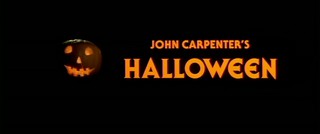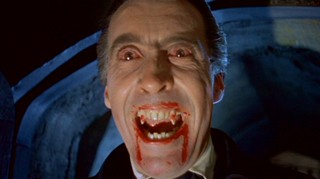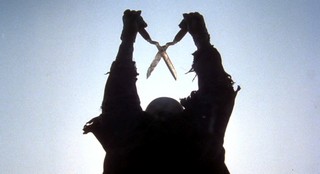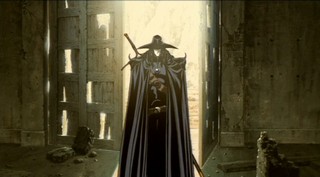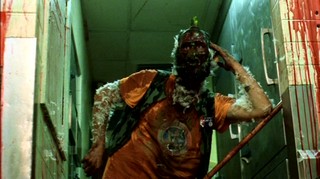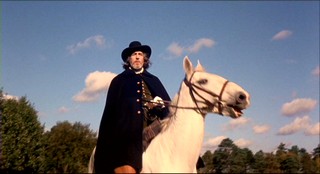There are certain RULES that one must abide by in order to successfully survive a horror movie. For instance, number one: you can never have sex. BIG NO NO! BIG NO NO! Sex equals death, okay? Number two: you can never drink or do drugs. The sin factor! It’s a sin. It’s an extension of number one. And number three: never, ever, ever under any circumstances say, “I’ll be right back.” Because you won’t be back. — Randy (Scream, 1996)
The slasher film is an unusual beast. It’s often criticized for its lack of originality, simplistic premises, repetitive nature, and strict adherence to formula. Of course, it’s often praised for such qualities as well. For fans of the slasher, watching a new film that follows the formula is like eating comfort food.
Ahhh, horror comfort food. Watching an ’80s bodycount film, I find, is relaxing. You kinda know what’s going to happen and all of the characters act in predictable ways, but that’s why it’s like putting a sweater on on a chilly day.
The funny thing about this is that the so-called formula isn’t exactly precise. I’ve written about genres in general before:
A genre is typically defined as a category of artistic expression marked by a distinctive style, form, or content. However, anyone who is familiar with genre film or literature knows that there are plenty of movies or books that are difficult to categorize. As such, specific genres such as horror, sci-fi, or comedy are actually quite inclusive. Some genres, Drama in particular, are incredibly broad and are often accompanied by the conventions of other genres (we call such pieces “cross-genre,” though I think you could argue that almost everything incorporates “Drama”). The point here is that there is often a blurry line between what constitutes one genre from another.
As such, it’s usually easy to spot a Slasher flick, even if there are lots of traits that are uncommon or unique. That being said, there are a number of characteristics common to a lot of slasher films:
- A Killer: Usually a lone, male killer, but not always.
- Victims: Usually more than two victims, introduced at the beginning and slowly killed off as the film progresses (in the manner of Ten Little Indians)
- A Survivor: Usually a female, and usually the main protagonist that defeats the killer in the end.
- Gratuitious Violence: Usually a variety of weaponry is used to dispatch the victims in a relatively gruesome manner. Rarely are impersonal weapons (such as guns) used, except in certain exotic cases (such as the speargun, common to the Friday the 13th series). More personal weapons, like knives and other bladed weapons, are usually the norm, and the result is generally depicted in gory detail.
- Sex: Nudity and sex are usually involved, and are generally indicators that those participating will die. Sometimes this is a deliberate commentary on sexuality, sometimes it’s just a more specific example of punishing those who are distracted.
- History: There is usually some tragedy in the past that is being revisited upon the present in some way. This is less common than the above tropes, but still frequent enough to be mentioned.
There are tons of other tropes that I could go into, but that covers a good portion of the conventions used in the slasher film. Another interesting thing about the slasher film is that while there are a number of Ur Examples (i.e. primitive slashers) and Trope Makers/Codifiers, there are some pretty distinct time periods that are important. Again, there are lots of pre-slashers, notably movies like Psycho and Black Christmas1, but for all intents and purposes, the slasher film started in 1978 with Halloween and went into overdrive with the release of Friday the 13th in 1980. The period between 1980 and 1983 saw the release of countless imitators and sequels, and by 1986, the sub-genre had slowed considerably2. There were still some series limping by (Friday the 13th, Halloween, Nightmare on Elm Street, etc…), but by the mid-90s, the sub-genre was all but dead. Wes Craven then revived things with the ultra-self-aware, mega-referential Scream, but by that point, the tropes of the sub-genre were so well established that subverting them became the order of the day. Post-Scream slashers don’t quite resemble the early 80s slashers and perhaps deserve their own sub-genre definition (neo-slashers?).3
So to me, the “true” slasher film was made between the years of 1978 and 1996, with the primary concentration being in the early 80s. Sure, there were a ton of influential films made before 1978 that featured or established important tropes, but none of those films even approached the success of Halloween and it’s imitators. Similarly, films made after Scream were forced to acknowledge the tropes and conventions of the sub-genre, and thus they shouldn’t really count.
In 1992, Carol Clover coined the term Final Girl to describe the lone surviving character at the end of slasher films, and a new controversy was born. Because of its seemingly rigid conventions, the slasher film is ripe for post-modern interpretations and deconstructions, and it’s easy to get carried away with such things. Clover started a more academic discussion of the sub-genre, and it’s continued for the past 18 years. The discussion has mostly revolved around the role of women in these films, with the general contention being that more women are killed than men, and in a more graphic way. There have been papers arguing one way or the other, and as you might expect, none are particularly definitive.
Which brings me to a relatively recent scholarly article, Sex and Violence in the Slasher Horror Film: A Content Analysis of Gender Differences in the Depiction of Violence (.pdf). Published in 2009, the article summarizes the existing arguments and, more notably, attempts to do a pretty thorough quantitative analysis of 50 slasher films.
The article is detailed and thorough enough that it would be of interest to any fans of the genre, even if it’s possible to nitpick a number of details in their methodology. Given what I wrote about above, I think you can see where my nitpicking was focused. In particular, I was baffled by the film sample list (see page 11).
Earlier in the article, the authors discuss previous efforts, and dismiss them for various reasons. One of the previous articles is criticized for a small sample size – which is a pretty legitimate criticism. Another is criticized because it selected films by commercial success:
The sample size
in the Molitor and Sapolsky (1993) study is adequate; however the decision to sample the most commercially successful films may raise problems with sample bias and interpretation of the findings (Molitor & Sapolsky, 1993; Sapolsky et al., 2003). Films featuring frequent presentations of extremely graphic violence may appeal to a smaller audience, generating lower box office revenues. Thus, the findings in the existing research may not reflect the true nature of violent presentations characteristic of the slasher subgenre.
This I find less valid, especially given the author’s concerns surrounding the impact of slasher films on society. If a film is not commercially successful, it is less influential, almost by definition.
All that being said, the authors came up with a new methodology which involved using IMDB’s power search capabilities. To my mind, their new methodology is probably just as problematic as previous studies. Their definition of the slasher sub-genre seems a bit broad, and as such, some of the films chosen as part of their study are questionable at best. For one thing, they include several pre-Halloween films and several post-Scream films, which dilutes the sample. Indeed, some of the films are arguably not even slashers. For instance, the inclusion of two Saw films seems like a bit of a stretch. It is true that Saw leverages some similar tropes, but it’s also one of the defining films in a different sub-genre – the “Torture Porn” film. Perhaps I’m splitting hairs, but I can’t imagine anyone jumping to Saw when asked to think of a slasher film.
The lack of any sort of measurement of influence is another issue. This is a more general problem, but it impacts this study in particular due to the random nature of the sample collection. For instance, there is no way that a movie like Cherry Falls should be used as a representative member of the slasher sub-genre. A study that focuses on commercial success of a film (i.e. box office and home video sales) would never have included that film.
Ultimately, these complaints amount to nitpicks. Even with these flaws, some of the study’s conclusions are still interesting:
Contrary to the findings reported in previous research, the current analysis suggests that there are several differences in the nature of violent presentations involving male and female characters. Male characters in slasher horror films are more likely to experience relatively quick, graphic, and serious acts of violence. Comparatively, female characters are more likely to be victims of less serious and less graphic forms of violence, such as stalking or confinement, with increased cinematic focus on depicting close-up states of prolonged terror. Women in slasher films are also more likely to be featured in scenes involving sexual content. Specifically, female characters are far more likely to be featured as partially or fully naked and, when sexual and violent images are concomitantly present, the film’s antagonist is significantly more likely to attack a woman.
This is ultimately not all that surprising, though I do wonder about a few things. For instance, since the Final Girl is a common convention, and since the final battle with the killer is likely to last a lot longer than earlier murders, it would make sense that the violence against women characters is less serious, but prolonged. I suppose one could also argue about the inclusion of non-physical violence as violence, which could get a bit hairy. The stats surrounding nudity and sex are also interesting, though I wonder how they would compare against other film genres (action films, for instance). The study presents the slasher as some sort of outlier, but I don’t know if that’s the case (not that it would excuse anything). I don’t know that any of these correlations can be tied to a causation, but it’s interesting nonetheless.
It’s an interesting article, and well worth a read for anyone interested in the sub-genre. Thanks to And Now the Screaming Starts for the pointer and stay tuned for the next installment of the Six Weeks of Halloween movie marathon. That’s all for now, but don’t worry, I’ll be right back!
1 I’m particularly fascinated by pre-slasher films, of which there are many. Psycho, Peeping Tom, Blood and Black Lace (and other Giallos), Twitch of the Death Nerve (aka Bay of Blood), The Texas Chain Saw Massacre, Black Christmas, Silent Night, Bloody Night, Alice Sweet Alice, The Hills Have Eyes, and so on. Even some older films nor normally associated with slashers presage the idea, like Thirteen Women or And Then There Were None.
2 In particular, April Fool’s Day and Jason Lives: Friday the 13th Part VI, both released in 1986, began to recognize the conventions of the genre and started the self-awareness trend that would culminate in Craven’s Scream. There are probably lots of other good slashers made during this 1986-1996 corridor, but the slasher film was seriously on the decline at that point.
3 It might be a bit insulting to Film Noir, but there are some parallels here. Critics basically defined the film noir after the fact and once that definition became popular, all new films that featured noir-like characteristics became known as neo-noir. Of course, this is not a perfect parallel, but there is a similarity here. Once people self-consciously started making noir films, they lost a certain quality, and the same is probably true for the slasher, and in particular, films like Scream and those that followed.

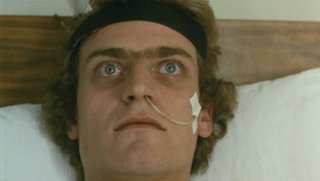
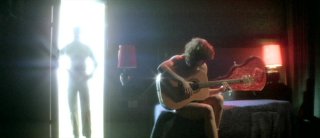
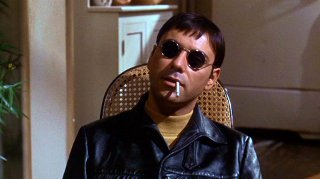
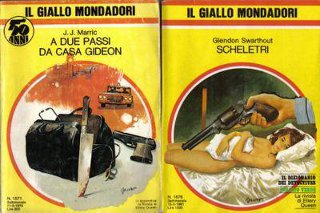
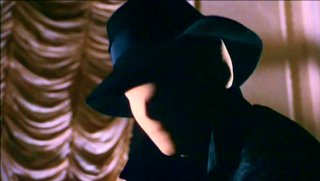
![Reblog this post [with Zemanta]](https://img.zemanta.com/reblog_e.png?x-id=03f9fa82-bd8f-46be-a23c-628810f34d68)
